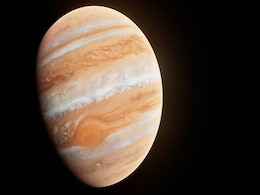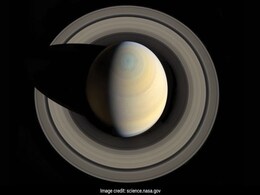Nasa Saturn Research
- All
- News
-

James Webb Telescope Captures Neptune’s Auroras in Stunning Detail
- Monday March 31, 2025
- Written by Gadgets 360 Staff
The James Webb Space Telescope has provided the first-ever direct images of Neptune’s auroras, revealing surprising details about the ice giant’s atmosphere. Unlike auroras on Earth, Jupiter, or Saturn, Neptune’s auroras appear across unexpected locations due to its tilted and offset magnetic field. Scientists also detected the presence of H...
-
 www.gadgets360.com
www.gadgets360.com
-

Enceladus' Geysers May Not Come from Underground Ocean, Study Suggests
- Friday March 7, 2025
- Written by Gadgets 360 Staff
Enceladus, one of Saturn’s most intriguing moons, has long been thought to have water plumes erupting from its underground ocean. However, a recent study proposes an alternative explanation, suggesting the plumes may originate from a semi-liquid layer within the moon’s ice shell. Researchers believe shear heating along fractures creates slushy,...
-
 www.gadgets360.com
www.gadgets360.com
-

Scientists Find Out Why Jupiter Doesn't Have Glorious Rings Like Saturn
- Tuesday July 26, 2022
- Bhavya Sukheja
Scientists have uncovered why Jupiter does not have rings like its neighbouring planet Saturn. Researchers from the University of California, Riverside, ran a computer simulation of both Jupiter's orbits and the four main moons that surrounded it to understand why the giant gaseous planet is missing the hoops.
-
 www.gadgets360.com
www.gadgets360.com
-

Saturn's Aurorae Fuelled by Planet's High-Altitude Winds, Research States
- Thursday February 10, 2022
- Edited by Gadgets 360 Newsdesk
An aurora is a beautiful display of natural lights in the sky, usually seen near the North and South Poles at night. Scientists have long believed that aurorae are created when the solar winds interact with the Earth's magnetic field — when streams of electrified particles emitted by the Sun are trapped in the magnetic field of the Earth.
-
 www.gadgets360.com
www.gadgets360.com
-

Researchers Rediscover 'Lost Planet' Using New Method in Another Step Towards Finding Habitable Planets
- Wednesday July 22, 2020
- Vineet Washington
Researchers from University of Warwick in the UK rediscovered the planet named NGTS-11b using the Next-Generation Transit Survey (NGTS) telescopes in Chile. The planet was originally found in 2018 using data from NASA’s TESS telescope which scans for a dip in light from the star to identify a planet.
-
 www.gadgets360.com
www.gadgets360.com
-

Saturn's Moon Titan Drifting Away 100 Times Faster Than Previous Belief
- Tuesday June 9, 2020
- Science | ANI
A new research led by scientists at NASA and the Italian Space Agency has implications for the entire Saturn system as well as other planets and moons.
-
 www.ndtv.com
www.ndtv.com
-

NASA Says Saturn Rings May Vanish In 100 Million Years
- Tuesday December 18, 2018
- Science | Indo-Asian News Service
Saturn is losing its iconic rings at the maximum rate estimated from Voyager 1 and 2 observations made decades ago, confirms new NASA research that estimates that the rings have less than 100 million years to live.
-
 www.ndtv.com
www.ndtv.com
-

NASA's Cassini Probe Of Saturn Prepares For Last Plunge
- Wednesday April 5, 2017
- World News | Agence France-Presse
NASA's unmanned Cassini spacecraft is preparing for its final plunge into Saturn later this year, after two decades of helping Earth-bound scientists make new discoveries about the sixth planet from the Sun and its mysterious rings.
-
 www.ndtv.com
www.ndtv.com
-

Scientists To Look For Aliens On Jupiter And Saturn's Icy Moons
- Monday April 25, 2016
- World News | Indo-Asian News Service
In one of its most ambitious projects in deep space, a team of NASA researchers are proposing to send robots at the centre of icy moons to explore the subsurface ocean for presence of life.
-
 www.ndtv.com
www.ndtv.com
-

Saturn's Moons May Be Younger Than Dinosaurs: Study
- Monday March 28, 2016
- Written by Vidhyanshu
By comparing present orbital tilts and those predicted by computer simulations, researchers could learn how much the orbits of Saturn's moons grew.
-
 www.gadgets360.com
www.gadgets360.com
-
Saturn's rings are 4.4 billion years old
- Friday January 3, 2014
- World News | Press Trust of India
Researchers using data from NASA's Cassini spacecraft have found that Saturn's rings formed around 4.4 billion years ago, shortly after the planet itself took shape.
-
 www.ndtv.com
www.ndtv.com
-
NASA's flexible rover could explore Saturn's moon Titan
- Tuesday December 31, 2013
- World News | Press Trust of India
NASA's proposed "Super Ball Bot" could hold the key to making landing a rover on another planet easier and far less expensive, researchers say.
-
 www.ndtv.com
www.ndtv.com
-

James Webb Telescope Captures Neptune’s Auroras in Stunning Detail
- Monday March 31, 2025
- Written by Gadgets 360 Staff
The James Webb Space Telescope has provided the first-ever direct images of Neptune’s auroras, revealing surprising details about the ice giant’s atmosphere. Unlike auroras on Earth, Jupiter, or Saturn, Neptune’s auroras appear across unexpected locations due to its tilted and offset magnetic field. Scientists also detected the presence of H...
-
 www.gadgets360.com
www.gadgets360.com
-

Enceladus' Geysers May Not Come from Underground Ocean, Study Suggests
- Friday March 7, 2025
- Written by Gadgets 360 Staff
Enceladus, one of Saturn’s most intriguing moons, has long been thought to have water plumes erupting from its underground ocean. However, a recent study proposes an alternative explanation, suggesting the plumes may originate from a semi-liquid layer within the moon’s ice shell. Researchers believe shear heating along fractures creates slushy,...
-
 www.gadgets360.com
www.gadgets360.com
-

Scientists Find Out Why Jupiter Doesn't Have Glorious Rings Like Saturn
- Tuesday July 26, 2022
- Bhavya Sukheja
Scientists have uncovered why Jupiter does not have rings like its neighbouring planet Saturn. Researchers from the University of California, Riverside, ran a computer simulation of both Jupiter's orbits and the four main moons that surrounded it to understand why the giant gaseous planet is missing the hoops.
-
 www.gadgets360.com
www.gadgets360.com
-

Saturn's Aurorae Fuelled by Planet's High-Altitude Winds, Research States
- Thursday February 10, 2022
- Edited by Gadgets 360 Newsdesk
An aurora is a beautiful display of natural lights in the sky, usually seen near the North and South Poles at night. Scientists have long believed that aurorae are created when the solar winds interact with the Earth's magnetic field — when streams of electrified particles emitted by the Sun are trapped in the magnetic field of the Earth.
-
 www.gadgets360.com
www.gadgets360.com
-

Researchers Rediscover 'Lost Planet' Using New Method in Another Step Towards Finding Habitable Planets
- Wednesday July 22, 2020
- Vineet Washington
Researchers from University of Warwick in the UK rediscovered the planet named NGTS-11b using the Next-Generation Transit Survey (NGTS) telescopes in Chile. The planet was originally found in 2018 using data from NASA’s TESS telescope which scans for a dip in light from the star to identify a planet.
-
 www.gadgets360.com
www.gadgets360.com
-

Saturn's Moon Titan Drifting Away 100 Times Faster Than Previous Belief
- Tuesday June 9, 2020
- Science | ANI
A new research led by scientists at NASA and the Italian Space Agency has implications for the entire Saturn system as well as other planets and moons.
-
 www.ndtv.com
www.ndtv.com
-

NASA Says Saturn Rings May Vanish In 100 Million Years
- Tuesday December 18, 2018
- Science | Indo-Asian News Service
Saturn is losing its iconic rings at the maximum rate estimated from Voyager 1 and 2 observations made decades ago, confirms new NASA research that estimates that the rings have less than 100 million years to live.
-
 www.ndtv.com
www.ndtv.com
-

NASA's Cassini Probe Of Saturn Prepares For Last Plunge
- Wednesday April 5, 2017
- World News | Agence France-Presse
NASA's unmanned Cassini spacecraft is preparing for its final plunge into Saturn later this year, after two decades of helping Earth-bound scientists make new discoveries about the sixth planet from the Sun and its mysterious rings.
-
 www.ndtv.com
www.ndtv.com
-

Scientists To Look For Aliens On Jupiter And Saturn's Icy Moons
- Monday April 25, 2016
- World News | Indo-Asian News Service
In one of its most ambitious projects in deep space, a team of NASA researchers are proposing to send robots at the centre of icy moons to explore the subsurface ocean for presence of life.
-
 www.ndtv.com
www.ndtv.com
-

Saturn's Moons May Be Younger Than Dinosaurs: Study
- Monday March 28, 2016
- Written by Vidhyanshu
By comparing present orbital tilts and those predicted by computer simulations, researchers could learn how much the orbits of Saturn's moons grew.
-
 www.gadgets360.com
www.gadgets360.com
-
Saturn's rings are 4.4 billion years old
- Friday January 3, 2014
- World News | Press Trust of India
Researchers using data from NASA's Cassini spacecraft have found that Saturn's rings formed around 4.4 billion years ago, shortly after the planet itself took shape.
-
 www.ndtv.com
www.ndtv.com
-
NASA's flexible rover could explore Saturn's moon Titan
- Tuesday December 31, 2013
- World News | Press Trust of India
NASA's proposed "Super Ball Bot" could hold the key to making landing a rover on another planet easier and far less expensive, researchers say.
-
 www.ndtv.com
www.ndtv.com














